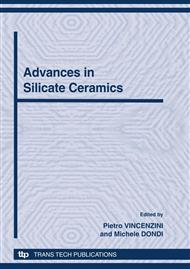p.153
p.159
p.165
p.176
p.182
p.194
p.202
p.208
p.213
Novel Ceramic Pigments Based on Industrial Wastes
Abstract:
We report the preparation of ceramic pigments using industrial wa stes as primary sources. An Al-rich sludge (generated in the wastewater treatment unit of an anodising or surface coating industrial plant), a galvanizing sludge (from the Cr/Ni plating process ), a Fe-rich sludge (generated during steel wiredrawing), a foundry sand and a marble sawing sludge are combined to formulate distinct pigment structures via the solid state reaction method. In particular, a black spinel and a novel blue pigment based on the hibonite structure are detailed. A green olivine, and brown and pink sphenes are also reported. The pigments were fully characterized, and then were tested in a standard transparent bright ceramic glaze. Typical working conditions and colour development are fully described.
Info:
Periodical:
Pages:
194-201
Citation:
Online since:
October 2010
Authors:
Keywords:
Price:
Сopyright:
© 2010 Trans Tech Publications Ltd. All Rights Reserved
Share:
Citation:


